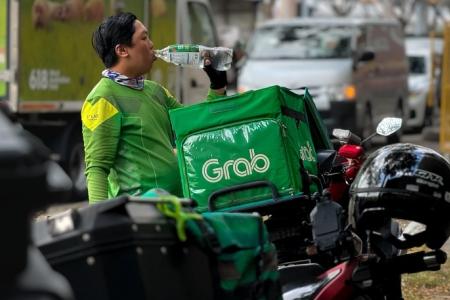Delivery riders endure longer hours, hotter days
Food delivery rider Roger hates standing still, especially when it is hot. “If I stop moving, that’s when the fatigue hits,” he said.
The hotter weather is taking a toll on him mentally, he said.
“If you keep getting orders, you’ll forget all the tiredness,” said Roger, 45, a full-time delivery rider for Deliveroo.
And he has to work harder these days just to make the same amount of money as a couple of years ago. He works 12 hours a day to make about $150 and earns about $3,000 a month to support his family.
“My wife works as well. If not, we really cannot survive,” the father of two told The Straits Times.
Like other riders who spoke to ST for this report, he did not want to use his full name.
Every day, thousands of motorcycle delivery riders like Roger take to the streets to satisfy the nation’s food cravings. The ultra-convenience of having anything from bubble tea to chicken rice, briyani and pizza delivered costs a few dollars. Peak times are lunch and dinner hours, and pretty much all day on Saturdays and Sundays.
But rising heat is making food delivery increasingly risky. Lower delivery fees, competition between food delivery companies and declining orders due to rising food prices translate into longer hours for motorcycle delivery riders to earn enough money.
Higher temperatures and longer hours of exposure to the heat can lead to fatigue and raise the risk of accidents – a major concern when motorcyclists are already among the most vulnerable groups on the road. Prolonged exposure and failure to get regular rest or drink enough water can also lead to kidney and heart illnesses.
Dr Mathew Mathews, who is head of the Social Lab at the Institute of Policy Studies (IPS) at NUS, said longer hours mean more heat exposure for riders. And that places them at greater risk of mishaps on the road.
“It is very evident that the longer a day that a rider works, there is a higher chance of accidents,” he told ST.
“Riders have expressed that there are days when the weather is much warmer than what they have ever experienced, and they feel completely drained after a few hours in the sun,” said Dr Mathews, who led a 2022 study by the IPS on food platform delivery workers in Singapore.
That study found that nearly a quarter of riders earn less than $1,000 a month, while a third earn between $1,000 and $1,999.
Most delivery riders ST spoke to said they felt it was getting hotter, and some have adjusted their hours. Some work mornings and evenings to avoid the hottest part of the day.
Mr Chong, 38, who works for Grab, said he tries to rest between 2pm and 5pm, which tends to be a quieter period during the week. He might complete only a few jobs during this afternoon period.
But Mr Chong, who has been riding full time for the past three years, said he was willing to be flexible in his work hours – some days, he works eight hours or nine hours, or up to 12 hours if demand is high.
Another rider, Mr Zarf, 25, said he feels it has definitely become hotter. “Mentally, you have to push through”, especially during busy periods, he said.
The motivation of riders, himself included, is to complete as many orders as possible, said Mr Zarf, who makes Grab food deliveries on weekends. “Grab provides us with incentives. So most of us just want to hit the incentive and go home.”
Incentives vary depending on the time of day and location, riders say. For example, Grab offers a minimum guaranteed payment for riders completing an afternoon shift, even if they are given only a few orders. The aim is to ensure there are riders available for prompt delivery.
Mr Zarf said he earns the most money during the busy dinner period and during wet weather, when there is surge pricing. But riders say there is no surge pricing during very hot days.
Hard to monitor
Rising heat is a growing risk for many outdoor workers. But because delivery riders are so mobile and are in essence freelancers, they are harder to manage and monitor.
Another key difference is that they are paid per delivery, meaning they are highly motivated to complete as many jobs as they can, running the risk of heat exhaustion.
It also means that the majority of government guidelines on managing heat stress remain voluntary and largely up to the riders to implement.
“It is not just locally but internationally. Not many have been paying attention to this group of workers. And because they are being paid for each delivery made, that is a significant risk,” said Associate Professor Jason Lee, director of the Heat Resilience and Performance Centre at NUS Medicine.
Other outdoor workers, such as those in construction, are usually paid a fixed salary, and can thus slow down or take more regular breaks to preserve their health without feeling like it impacts their income.
The authorities could not provide ST with data on cases of heat injuries or deaths involving outdoor workers such as delivery riders.
Prof Lee said there is an urgent need to better quantify the direct and indirect consequences of heat stress on the health, safety and productivity of delivery riders in Singapore. Having a clearer idea of the physical limits for riders during hot weather can guide riders on when to take mandatory breaks to rest and rehydrate.
For instance, one can set a limit on the number of deliveries within a certain time period without compromising riders’ earnings. Delivery platforms could charge a premium for delivery on hot days.
This would also benefit food delivery companies, because it would reduce illness without compromising productivity.
Messaging is also an issue, Prof Lee said. Current top-down reminders to riders to take breaks for the sake of their health would be ignored by riders intent on maximising their earnings by taking on as many deliveries as possible.
“I feel guidance on breaks and hydration will likely fall short with riders unless their financial concerns are addressed,” Prof Lee said.
“To ensure uptake, it’s crucial to safeguard their income. Collaborating with employers and clients to cover additional costs or provide compensation for extended breaks may be necessary.”
What riders and delivery firms need to see is the bigger picture – that taking undue risks leads to wider social consequences of long-term damage to health and even death in accidents.
“When we are advocating heat measures, it is not just providing welfare. The welfare is also good for business,” said Prof Lee. This is key to getting food delivery firms on board, he said.
Better safeguards
The Ministry of Manpower (MOM) introduced enhanced heat stress measures in October 2023 to better protect outdoor workers.
These include workers rehydrating at least every hour, providing cool or cold drinking water supply near work areas, and ensuring workers get adequate rest under shade to allow for recovery.
But these steps are difficult to enforce for highly mobile delivery riders.
The ministry told ST it is important for food delivery firms to educate food delivery platform workers of the symptoms and consequences of heat-related illnesses.
Efforts to strengthen the safety and health protections for platform workers are ongoing, MOM said. “The ministry will step up checks when efforts to strengthen protections for platform workers come into effect.”
A Bill was tabled in Parliament on Aug 6 that spells out better safeguards for delivery riders, including a standardised work injury compensation regime, retirement income and formal representation.
The association representing delivery riders also wants stronger efforts to support riders. The National Delivery Champions Association (NDCA) called on delivery platform operators, merchants and customers to prioritise delivery workers’ safety and well-being.
“NDCA has sought the understanding and assurance of platform operators that riders and walkers can pause accepting orders to seek shelter during bad weather without fear of penalties,” said Ms Jean See, NDCA’s executive secretary.
Merchants, especially those located outdoors, can help by ensuring prompt preparation of food orders to minimise having delivery workers waiting in unsheltered areas or by the roadside. And restaurants and places such as malls can provide sheltered rest areas and cool drinks for delivery workers, Ms See told ST.
“These gestures and actions make delivering in a hotter and wetter Singapore more bearable for our delivery workers,” she said.
But are delivery firms doing enough to support and educate their riders about heat risks?
“No” was the near-universal reply from riders ST spoke to.
“No way. It really depends on the gods,” one rider said.
Riders’ risk of heat stress: What the food delivery firms say
Grab, Deliveroo and foodpanda told The Straits Times they are aware that hot weather is a risk to riders’ health and safety.
All three companies said they issued heat advisories to their riders via their apps or message chat groups on protecting themselves from heat stress, such as by taking regular breaks to rehydrate.
“These alerts include regular reminders to wear suitable protective gear, stay hydrated and take breaks if they need to,” a foodpanda spokesman said.
The companies said they do not mandate breaks, preferring the riders to make the choice. Riders can adjust how much they are looking to work during periods of warm weather, a Deliveroo spokesman said.
Grab said: “We do prompt driver-partners to take a break when they have hit a certain number of online hours to prevent exhaustion.”
Delivery platform foodpanda said it has introduced “Excused Breaks” in which riders take five-minute breaks each hour, “while still enjoying any applicable incentives”.
Deliveroo said it does not impose time limits on riders to complete their deliveries or provide incentives for fast deliveries. Nor does it penalise riders rejecting orders due to challenging weather conditions.
For all riders using the three platforms, steps to help them cope include providing lightweight ultraviolet-resistant clothing as well as rest areas with food and drinks.
“With temperatures rising, we recognise the need to ensure that our delivery-partners can perform their duties safely and comfortably,” the Grab spokesman said.
- Additional reporting by Kok Yufeng
Get The New Paper on your phone with the free TNP app. Download from the Apple App Store or Google Play Store now


